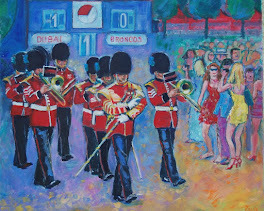RESHAPING THE HUMAN FIGURE: FROM ANTIQUITY TO MAPPLETHORPE
What an excellent lecture last week at Richmond on Thames as part of a series of lectures organized by the Richmond Art Society.
NATIONAL GALLERY
Colin Wiggins started by telling us that he is now Curator of Special Projects at the National Gallery.
Until recently he was Head of Education there.
He gave a one hour lecture with the above title, showing the continuity which is evident in Western Europen art, depicting and sculpting the human figure from sources in Antiquity.
During this lecture he made many witty comments about modern practices in art; he said that the Leonard da Vince exhibition was a thorn in his side at present and that they had had 'turned David Hockey away this morning'.
He began by saying the central foundation stone of Western European art is 'us', in other words, the human figure. Of these works, the male figure is the most important. He commenced by showing slides of sculpture of the male from ancient Greece.
 |
| Greek sculpture |
He showed immediate links to figures sculpted by Michaelangelo, and paintings by Velazquez and Lucien Freud.
This was demonstrated by a projected image of a Roman god next to a painting of the god Mars by Velazquez and a nude full-length portrait of Leigh Bowery by Lucien Freud.
 |
| Mars by Velazquez |
 |
| Top part of Leigh Bowery portrait |
Colin had many slides demonstrating his points, all of them interesting and relevant, particularly the works of the Italian Renaissance artists, such Raphael, who, he said, was not able to work from the nude female figure, it being impossible for a young man to have access to a nude female model.
Also we were asked to look at the Joshua Reynolds portrait of Sir BanastreTarleton, who fought in the American War of Independence. Reynold had a directory of poses, from his time in Rome, and used a pose of Cincinnatus from antiquity for the Tarleton portrait. Tarleton was apparently very 'thick' and Reynolds did not like him at all. He painted the figure in a battle scene with a cannon right behind his backside!
 |
| Cincinnatus sculpture |
 |
| Sir Banastre Tarleton by Reynolds |
The interest in ancient art was widespread in the USA too, from Victorian times, and he told of a mail order facility to order art from Europe, which resulted in a copy of the Venus de Milo being sent by railroad to the mid-west, where it was found to be without arms. The purchasers sued the railroad company for the loss of her arms, and won their case!
 |
| Veus de Milo |
There was a very amusing point made that maidens were painted and sculpted being very modest, and while nude, covered their 'private parts'. This he demonstrated by showing us a sculpture of a Roman or Greek (not sure which) girl, then a nude by Renoir
 |
| Bather by Renoir |
 | ||
| Still from Carry on Camping |
Colin admires the 'passive and beautiful' male nudes of David Hockney and is looking forward to the exhibition later this year at the Royal Academy.
However he did not like the Gerhard Richter work at the London exhibition (now ended), and said he finds German contemporary art takes itself too seriously.
TATE GALLERY, LONDON
My understanding is Colin suggested he likes humour in art and showed us a Johann Zoffany painting of the Tribuna in the Uffizi, Florence, where a collection of Milords are admiring the bottom of the Venus de Milo.
Johann Zoffany - more about him
I found a link to the Fitzwilliam Museum, Cambridge which shows Frank Auerbach standing beside a portrait etching of Colin Wiggins.
FITZWILLIAM MUSEUM, CAMBRIDGE
COLIN WIGGINS - HE IS A 'NATIONAL (GALLERY) TREASURE'





















